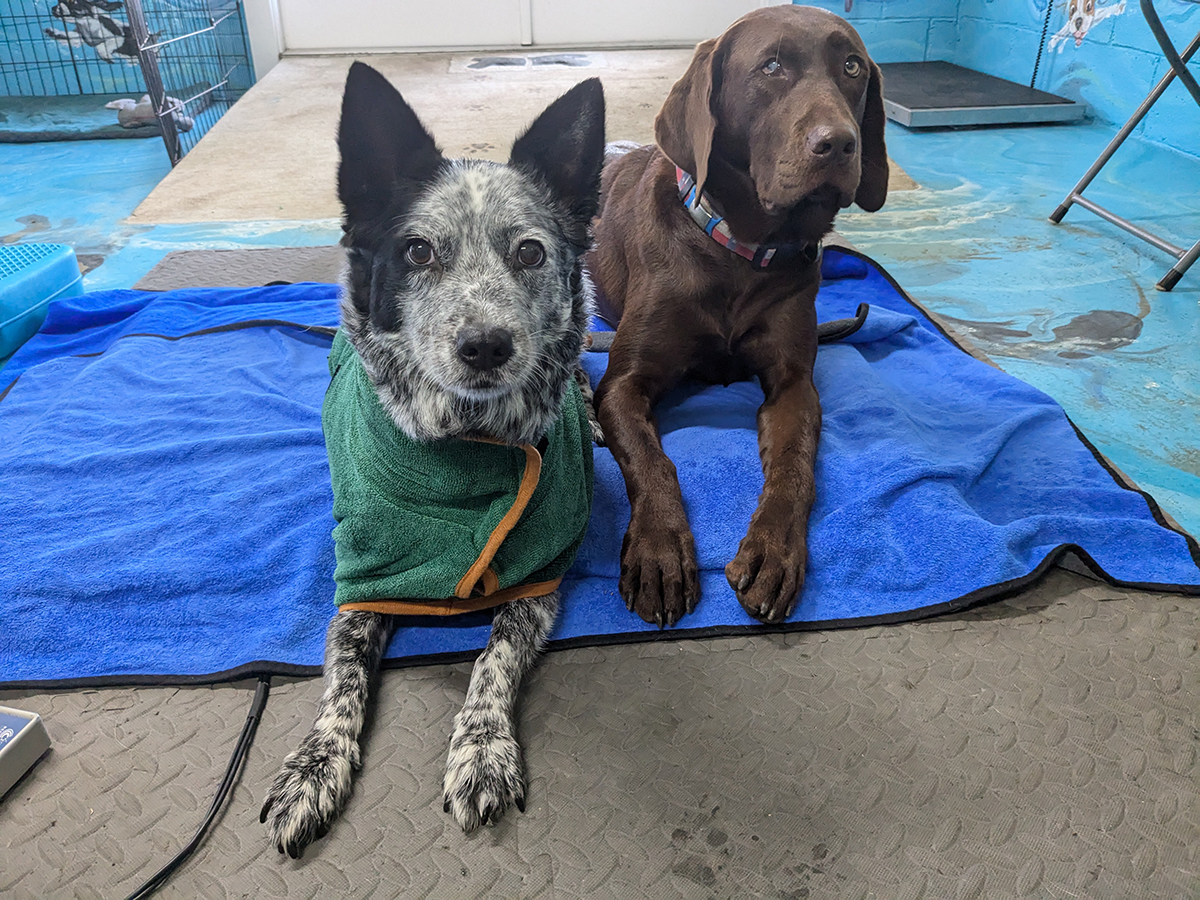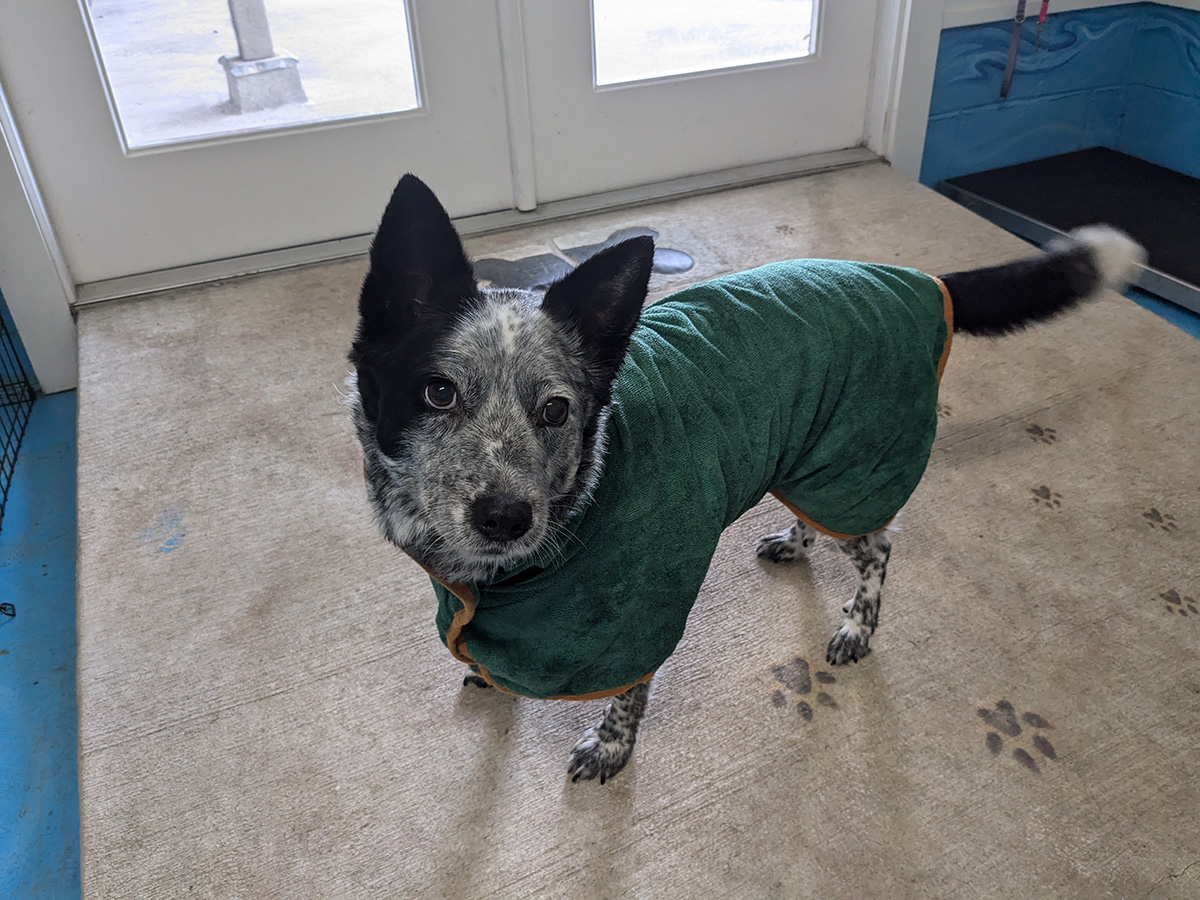The following is a case study of a cattle dog named Tootsie Roll written by Dr. Ross of Big Island Pet Care Center in her own words. She hopes sharing the story of this one pup will inspire pet owners to seek rehabilitation therapy for their own pets in need.
The Pain of a Dog with Degenerative Joint Disease
“Routine, routine, routine. . . uh-oh, what’s this?” I mumbled as I looked through the appointment schedule for the day.
Tootsie. Cannot move or stand up.
Tootsie was a rehabilitation patient of mine with severe degenerative joint disease, but I hadn’t seen her in almost six months. At the time of her last appointment, the owner felt she was stable and doing okay and opted to discontinue her monthly rehab sessions. I didn’t hear much more from him – a request for a refill on a supplement – and had assumed everything was going okay. Until this day.
I walked into the exam room where Tootsie was lying on a blanket up against the wall. Her tail wagged slowly as I looked at her face; when I reached down to examine her, she flinched, her muscles twitching uncontrollably as I gently manipulated her limbs before she quickly turned her head and nipped at my hand. Painful. Very painful.
I noted the dampness in the corner of the owner’s eyes. “She’s very painful.”
“I know,” he said. “I just don’t know what to do. She was doing okay, and then the supplements and everything, it got to be too much. . . and now she can’t walk, and I don’t have the strength to carry her or help her.” I let the silence linger. “I don’t know what to do. I can’t give her the care she needs. . . ” His voice trailed off. “Is it time?” he whispered.
Making a Difficult Decision
As a veterinarian, this is not an uncommon scenario: an aging animal with deteriorating mobility and unmanaged pain, an owner unable to care for the pet’s needs, whether due to their own physical limitations or financial constraints, despite their desire to do so. It often makes for very heartbreaking and difficult decisions.
Giving This Pet a Second Chance
“I don’t know, Mr. M,” I answered. “She’s painful, but that can be addressed. I know you have some financial constraints. Can anyone in your family – your kids – help?”
“I have been talking with them, but. . . ” Mr. M paused. He had taken Tootsie less than two years previously as a favor to a friend who was unable to care for her – the position he found himself in now.
Tootsie continued to gaze at me during this exchange. She clearly was still engaged with her environment and interested in what was going on. Prior to this appointment, my relationship with Tootsie had been. . . well, not adversarial, but she wasn’t the most cooperative patient and usually positioned herself at her dad’s legs or under his chair when I was trying to work on her.
“Let’s try some pain medications this week,” I suggested. “I would like you to contact some of the local rescues to see if you can get some financial help or help finding another placement for her. I’ll have you come back next week, and we’ll reassess the options.”
Mr. M agreed to this, and my assistant carried Tootsie out to the car for him.
The week went by quickly, and before I knew it, Tootsie was waiting for me in the exam room again. She was standing! But quickly collapsed after wagging her tail and taking two steps. Progress, but obviously in need of additional care.
The news from Mr. M was sobering – though not unexpected. “None of the rescues have space or can help me,” he said. His voice wavered. “I can’t give her the care she needs, and I don’t want her to suffer, so. . .” Tears were rolling down his face.
Like last week, Tootsie’s gaze was locked on me. Something shifted.
“Would you be willing to sign her over to me?” I asked. “Give up ownership and any interest or news in how she is doing?”
Relief washed over his face. He didn’t answer immediately, nor did he smile. But he looked at Tootsie and said, “I know you will give her the best care possible, and she will have a good life for however many years she has left.”
How Rehabilitation Therapy Saved One Happy Dog
As a rehab-focused veterinarian, I rarely have the opportunity to do everything for a patient. That is, I can make diagnostic recommendations (X-rays for example) and treatment recommendations, but we all have limitations on what can be done for any particular patient. While it may be ideal for them to receive laser treatment daily for two weeks, that rarely happens, due to time limitations and cost constraints. Rehabilitation therapy for a dog like Tootsie requires considerable commitment of both time and finances.
Once the paperwork had been signed, granting me ownership of Tootsie, I did bloodwork and X-rays. Bloodwork was beautiful – very healthy. X-rays, not so much. Severe hip dysplasia bilaterally and cruciate disease bilaterally as well. Left stifle completely unstable. Right elbow dysplasia and arthritis. It’s no wonder she couldn’t walk!
Weight loss, diet change, nutraceuticals. Twice daily treatment for two weeks. Joint injections. Hydrotherapy. The power of rehabilitation therapy: three months later Tootsie is running around in the yard, barking at the neighbor cows, bossing the bigger dogs around, and living her best life. She has an abnormal gait, to be sure, and always will. But she is a happy girl, had no surgery to stabilize her joints, and is not on any pharmaceuticals. She continues to have daily therapy – either PEMF or laser, as well as hydrotherapy several times a week. She’s on joint support and a great diet. And she continues to build strength in her hind end.
I’m so thankful for that intense cattle dog gaze that spoke to my heart, giving me the opportunity for professional growth while restoring a good quality of life for one little Tootsie Roll.
- Dr. Ross

Find Healing for Your Pet Through Rehabilitation Therapy
Big Island Pet Care Center is proud to share stories from our veterinarians about pets they have treated. Do you have a cat or dog in Keaau or nearby areas like Hawaiian Paradise Park that you think may benefit from rehabilitation therapy? Contact us to set up a consultation with Dr. Ross or another of our experienced veterinarians to discuss treatment options for your pet.

